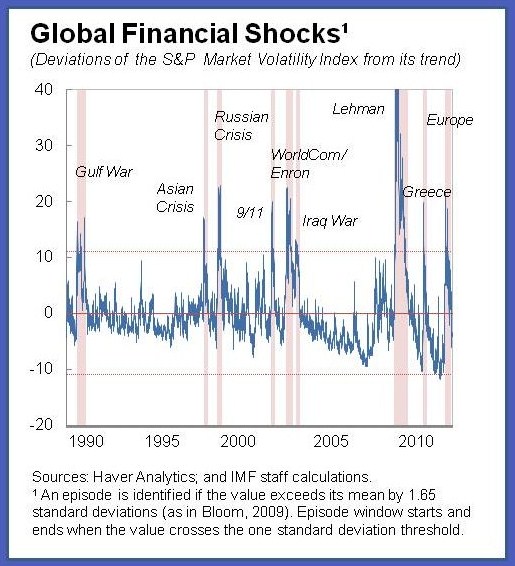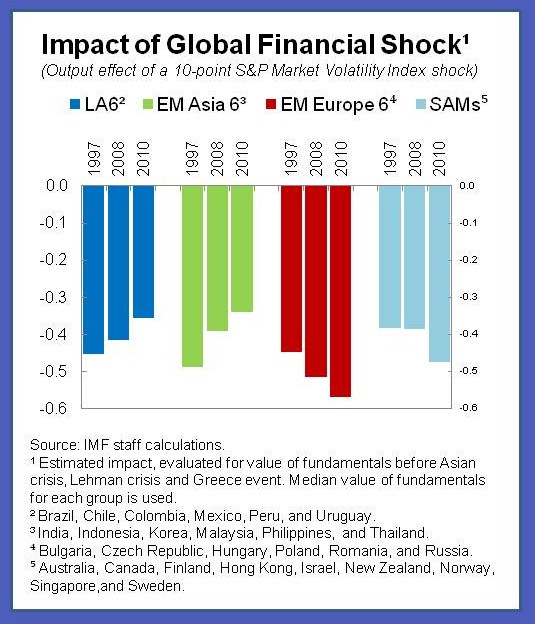Latin America has a long history of accidents that have occurred while navigating turbulent financial international waters. With risks looming over the world economy, should the region worry about new global financial waves?
Global financial markets have seen frequent bouts of severe stress since 2008, although this isn’t really anything new for the region. Global financial shocks have occurred on average every 2½ years since 1990, with significant effects on Latin America.
But how costly are these shocks in terms of domestic output, and is Latin America better placed to cope with them this time?
In Chapter 3 of the IMF’s latest Regional Economic Outlook: Western Hemisphere, we analyze whether changes in underlying fundamentals have made the region more or less vulnerable over time. The analysis, which complements our work on the effects of terms-of-trade shocks, looks at what country features and policies make a difference. We focus here solely on the impact of the financial shocks by isolating the effect from commodity prices and global demand shocks.
Opposing forces
The impact of external financial shocks on domestic output in emerging economies generally depends on two factors: the extent of financial linkages (integration) with the rest of the world, and the strength of the country’s economic fundamentals.
A higher degree of financial integration arguably increases a country’s sensitivity to external financial shocks. Stronger fundamentals, on the other hand, tend to mitigate the impact of these shocks—both by helping maintain confidence on domestic macroeconomic management and so discouraging capital outflows, and by easing the economic adjustment following a given external shock.
To assess the effects of global shocks, it is therefore necessary to examine where Latin America stands in these two areas.
Over the past two decades, financial integration has deepened in Latin America.
At the same time, key economic fundamentals have improved markedly, particularly those related to external and fiscal sustainability. Thus, given these opposing forces, it isn’t immediately clear whether Latin America is more or less vulnerable to financial shocks today than in the past.
Assessing what makes a difference
To shed light on this question, we studied the behavior of 40 emerging and 9 small advanced economies during seven episodes of global financial stress since 1990, and assessed the importance of different economic fundamentals in amplifying or mitigating the impact of these shocks. Our analysis yields some interesting insights:
- Exchange rate flexibility is a key shock absorber, especially for financially integrated economies.
- A country’s external position (for example, its current account balance and external debt) also plays a part in determining how well a country does during times of external crisis.
- Higher financial integration does not always increase a country’s vulnerability to external financial shocks. The country’s exchange rate regime is critical for this relationship: financial integration amplifies financial shocks in economies with fixed exchange rate regimes, but mitigates those shocks in economies with more flexible regimes.
Overall, this means that financially integrated economies with strong fundamentals (especially exchange rate flexibility) are better equipped to cope with global financial shocks than countries with weak fundamentals and limited financial linkages.
Where does Latin America stand?
Our research shows that the progress made by Latin America on economic fundamentals appears to have paid off.
Simulations show that despite increasing financial integration, output costs associated with global financial shocks in Latin America have declined in the past 15 years. Of course, the progress made so far does not make the region immune, but has helped it to ride more safely through the recent global financial waves.
As we’ve pointed out previously, the region should take precautions in case of a bigger global downturn. But so far it can take credit for its hard work on the policy front.









